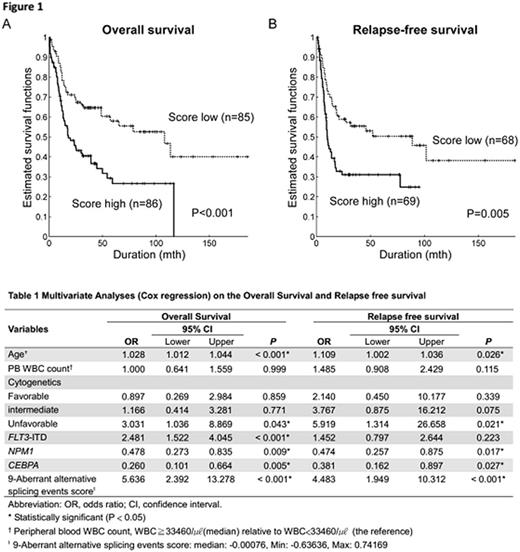Abstract
Background
Aberrant alternative splicing (AS) were reported important in the pathogenesis and prognosis of acute myeloid leukemia (AML). Previous studies reported inferior outcomes in AML patients carrying mutations in genes encoding RNA-splicing proteins, which accounted for 18% of AML patients. However, whether aberrant AS is correlated with these mutations or carried clinical and biological significances in AML patients remain unknown. In this study, we aimed to answer these questions by a set of array data from a large cohort.
Materials and Methods
A total of 171 newly diagnosed non-M3 AML patients, who received standard induction chemotherapy and had complete clinical and genetic information were enrolled. There were 20 healthy marrow donors for comparison. We extracted RNA from mononuclear cells (MNC) in the bone marrow (BM), followed by hybridization on the microarrays of Affymetrix Human Transcriptome Array 2.0, which contained >6 million distinct probes covering 44710 coding, 22829 non-coding transcripts, and exon-exon junctions. This comprehensive coverage facilitated investigation of the global splicing patterns. The splicing index (SI) of a probe in a gene was derived from the ratio between AML patients and normal controls in terms of the probe intensity divided by the gene expression level, i.e., SI = [(intensity of probe A in gene A) / (gene A expression level)] of AML patient / [(intensity of probe A in gene A) / (gene A expression level)] of normal control. When the value is less than 1, SI is defined as the negative reciprocal. SI had to be less than -2 or more than 2 to be denoted as an aberrant AS event. A gene with at least one aberrant AS event would be called an aberrant AS gene. SI values were log2 transformed and analyzed for the association with overall survival (OS) by the univariable Cox proportional hazards model. Functional annotation for significant aberrant AS events was performed by the Database for Annotation, Visualization and Integrated Discovery (DAVID) web tool with default settings. The aberrant AS events were then merged into a Least Absolute Shrinkage and Selection Operator (LASSO) regression, which identified the best subset of aberrant AS events for the prediction of OS. We adopted a leave-one-out cross validation scheme to identify the subset with the best performance. A beta value was assigned to each of the selected aberrant AS events by LASSO. Based on the results, we constructed a scoring system by a weighted sum of the selected features, where the weights were LASSO beta values. The scoring system was applied to predict OS and relapse-free survival (RFS).
Results
At first, univariable Cox analysis identified 95 OS-associated aberrant AS events (P<0.01; n=171) in 69 coding and 6 non-coding genes. A DAVID analysis was performed to explore the functional relevance of these events. Of note, 41 of the involved coding genes were known involved in RNA splicing pathways (P=0.049). Furthermore, the aberrant AS genes were associated with AMPK signaling pathway (P=0.007), PI3K-Akt signaling pathway (P=0.025), and HIF-1 signaling pathway (P=0.042). We used a LASSO regression model to identify the subset of aberrant AS events that best predicted OS by a leave-one-out cross validation test. As a result, a simple scoring system of 9 aberrant AS events was developed. The system was composed of a weighted sum of aberrant AS events on APP, CD93, CT45A3, CUX2, PIK3R3, RORA, SCRN1, and ZSCAN31, and a non-coding transcript. A high score was predictive of inferior OS (Figure 1A; P<0.001; median survival, 18.0 and 108.1 months) and RFS (Figure 1B; P=0.005; median survival, 10.2 vs. 88.8 months; n=137). Patients with detectable mutations in spliceosome (n=16) did not have a higher aberrant AS score (P=0.589). Age, hemogram, cytogenetics, and FAB classification were not correlated with aberrant AS score, either. However, a higher score was predictive of lower complete remission rate (P=0.01), a higher relapse rate (P=0.006), and higher incidence of FLT-3 -ITD. In addition, multivariate analyses revealed a higher aberrant AS score as an unfavorable prognostic factor for OS and RFS (both P< 0.001) independent of age, WBC counts, cytogenetics, genetic mutations of NPM1 and CEBPA and FLT-3 -ITD (Table 1).
We present the clinical significance and prognostic impact of an aberrant AS scoring system in de novo, non-M3 AML patients. Large prospective cohorts are needed to confirm our observations.
Tang: Celgene International Sàrl: Research Funding. Yao: Celgene International Sàrl: Research Funding. Li: Celgene International Sàrl: Research Funding. Huang: Celgene International Sàrl: Research Funding. Ko: Celgene International Sàrl: Research Funding. Hsu: Celgene International Sàrl: Research Funding. Lin: Celgene International Sàrl: Research Funding. Wu: Celgene International Sàrl: Research Funding. Tsai: Celgene International Sàrl: Research Funding. Tien: Celgene International Sàrl: Research Funding.
Author notes
Asterisk with author names denotes non-ASH members.


This feature is available to Subscribers Only
Sign In or Create an Account Close Modal